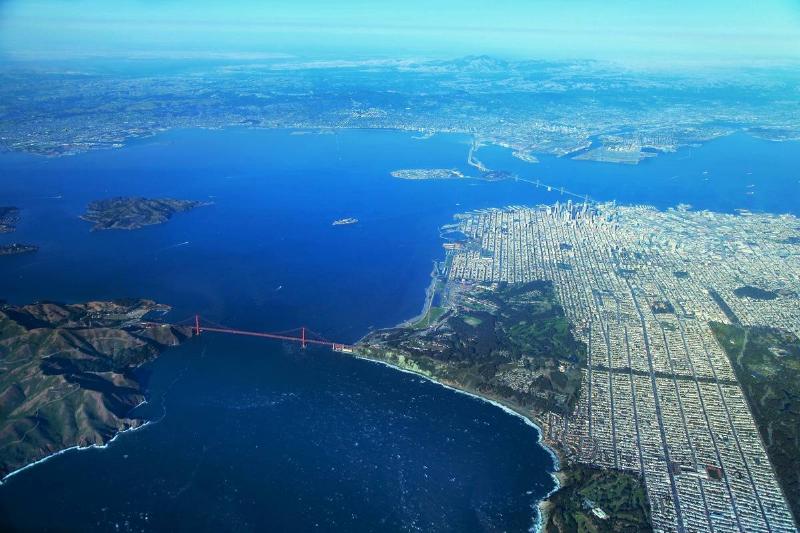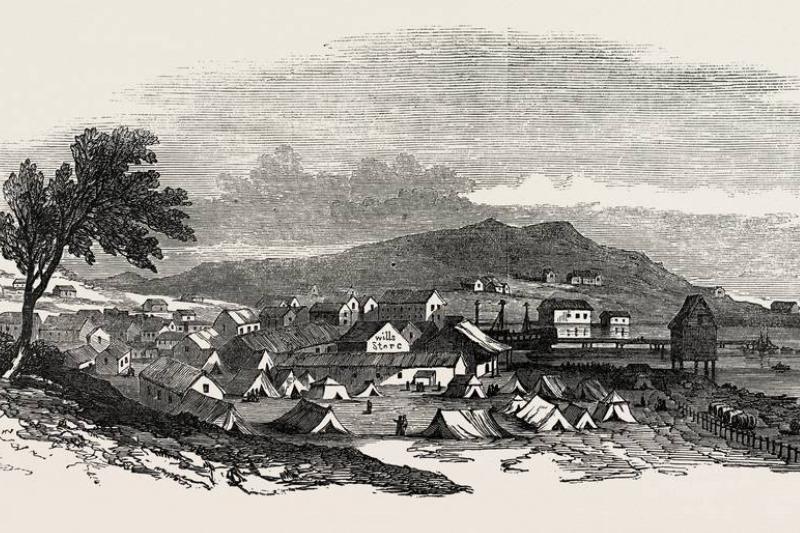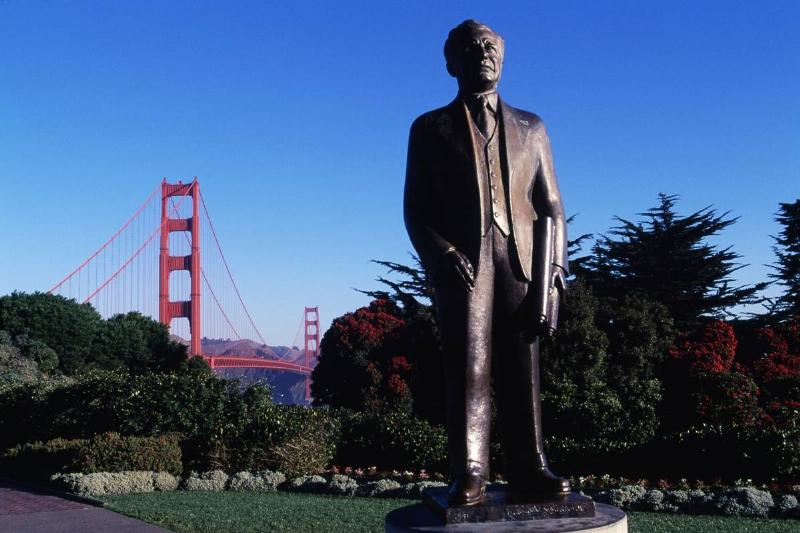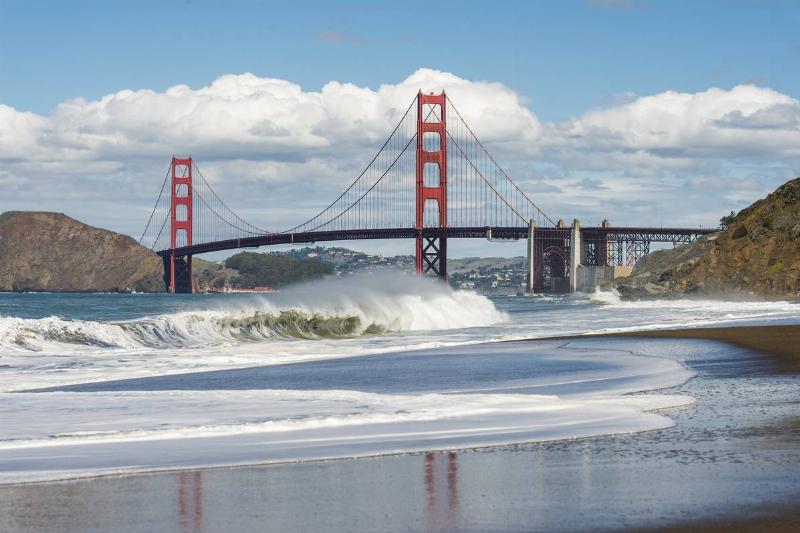Thought to be lost forever, researchers make remarkable discoveries of what’s under the Golden Gate Bridge
Researchers from the National Oceanic and Atmospheric Administration (NOAA) used sonar scans of the ocean floor west of the Golden Gate Bridge, then robotics. Here’s what they found.
The following written content from Explored Planet

Since 1937, the Golden Gate Bridge has spanned the Golden Gate strait, connecting the San Francisco Bay to the Pacific Ocean. And while the structure is something to behold, there is more than one mystery lurking underneath it in the waters.
With the help of some underwater robots, the National Oceanic and Atmospheric Administration (NOAA) has made it their goal to uncover the ghostly secrets hidden underneath the Golden Gate Bridge. What they found is eerie in the most extraordinary way.
The Golden Gate Bridge is one of the United States’ most famous landmarks
Spanning almost two miles across the San Francisco Bay, the Golden Gate Bridge’s rust-colored structure is arguably one of America’s most famous landmarks. People from all over travel to the San Francisco area to marvel at its engineering. Xinhua/Wu Xiaoling via Getty Images
Xinhua/Wu Xiaoling via Getty Images
But while people look up at the bridge, they forget that the water it towers over holds more than one secret of its own. Now, with the help of underwater robots, NOAA has made it their mission to uncover stories from the past.
The bridge might be a famous landmark now, but the bay wasn’t found right away. Keep going to find out when explorers first found it!
Advertisement
The Bridge Has Around 27,000 Visitors Per Day

Paul Chinn/The San Francisco Chronicle via Getty Images
According to Bold Italic, around 27,000 visitors venture to the Golden Gate Bridge per day. That’s a lot of people marveling at what the American Society of Civil Engineers calls one of the Wonders of the Modern World.
Bridge maintenance at the George Washington Bridge
Check out one of the most dangerous jobs
But what people don’t think about it while they are looking up at a feat of engineering comparable to that of the Panama Canal, they forget that there is a whole other story lurking in its watery shadow.
377-Feet Deep And Full Of Mystery
 DigitalGlobe via Getty Images via Getty Images
DigitalGlobe via Getty Images via Getty Images
At around 377 feet at its deepest point, the waters underneath the Golden Gate Bridge are bound to hold more than one ghostly tale from the past. And the National Oceanic and Atmospheric Administration has made it their mission to bring the eerie tales to the surface.
Now, it’s just a matter of using their remotely operated underwater robots to search the Golden Gate strait’s floor to uncover whatever time and water currents have hidden.
It Is One Of The World’s Natural Harbors

Gili Yaari/NurPhoto via Getty Images
The thing is, NOAA’s excavation plan isn’t as easy as it sounds. The Golden Gate strait is nothing more than a tiny, mile-wide stretch of water, connecting the San Francisco Bay to the Pacific Ocean. And it is notorious for keeping treasures well hidden under its waves.
As one of the world’s natural harbors, historians find it amazing that the Spanish conquistadors knew nothing of it, sailing right past when they first landed on California soil.
The Bay Was Hidden Until The 18th Century

Marji Lang/LightRocket via Getty Images
Notorious for being covered in a layer of fog for a solid amount of the time and surrounded by rocky terrain, rough waters, and more than one sea predator, NOAA had their work cut out for them.
There is a reason the Bay stayed hidden until the Spanish finally stumbled upon it in the 18th century since getting through the strait was anything but smooth sailing. More than one ship found itself smashed upon the rocks. But NOAA wasn’t going to let that stop their plan.
There was a reason why the bay remained hidden, and the reason is coming up next.
Many People Were At The Mercy Of The Water
 Tayfun Coskun/Anadolu Agency/Getty Images
Tayfun Coskun/Anadolu Agency/Getty Images
With the wild currents of the Pacific Ocean, disaster often struck those who tried to make it through to the safety of the Bay. Lacking navigational charts and instruments, early northern California settlers had nothing to go on but their own sight.
Which, honestly, is the best when going through an area known for its fog storms. Even so, enough made it past the strait, into the Bay, and were able to settle on the shores surrounding the harbor.
Everything Changed With Captain John Montgomery
 DEA/BIBLIOTECA AMBROSIANA/Getty Images
DEA/BIBLIOTECA AMBROSIANA/Getty Images
First settled by the Spanish on June 27, 1776, it took more than a few years for Yerba Buena to cede to the rest of the United States. Then, in 1846, Captain John Montgomery sailed to the bay, claiming the land for the United States, meeting no resistance, and planting the first American flag upon its shores.
A year later, Yerba Buena was renamed, San Francisco. And, in 1850, California became the 31st state of the United States, just in time for the Gold Rush.
The Population Kept Growing
 Buyenlarge/Getty Images
Buyenlarge/Getty Images
Even after the hype of the California Gold Rush died down in 1855, San Francisco’s bay was still one of the most important ports around. With so many people arriving on the shores of San Francisco via ship, it was time to figure out how to conquer the harsh strait.
But it was going to be a long time before the Golden Gate Bridge became a staple landmark of the Bay Area.
San Francisco Was Behind Other Cities

Universal History Archive/Universal Images Group via Getty Images
Before the rusty-colored Golden Gate Bridge spanned the waters of the Golden Gate strait, people would arrive at the shores of San Francisco via boat, the easiest way to make it across the strait.
The thing is, the hidden area was hindering the city’s growth. Its isolation made it so goods were hard to get into the city. San Francisco wasn’t growing at nearly the same pace as the rest of the American metropolises.
Coming up soon, find out what makes NOAA so well-equipped to tackle the mysteries of the Golden Gate strait.
It Was Time To Find A Solution
 Universal History Archive/Universal Images Group via Getty Images
Universal History Archive/Universal Images Group via Getty Images
So, the brainstorming began. And people began to think of a different way to get people across the Bay that didn’t involve a ferry-type service. Ironically, the thought of building a bridge wasn’t thought possible.
The uncertain foggy weather of the northern California coast, not to mention the harsh currents and tides of the Golden Gate strait, aren’t the best conditions to do construction. But that doesn’t mean people completely ignored the idea.
The 1915 World’s Fair Was Just The Start
 Schenectady Museum; Hall of Electrical History Foundation/CORBIS/Corbis via Getty Images
Schenectady Museum; Hall of Electrical History Foundation/CORBIS/Corbis via Getty Images
While many people didn’t believe such a structure could ever be created, they knew if it were possible, it would be something incredible — large enough to span the strait and tall enough to allow larger ships to still pass underneath it into the bay.
It wasn’t until 1915, in the aftermath of The Panama–Pacific International Exposition world’s fair held in San Francisco, that the idea of a grand bridge actually started to take shape.
The Proposal: A Combined Cantilever And Suspension Bridge

DeAgostini/Getty Images
Engineer Joseph B. Strauss was the first to propose a combined cantilever and suspension bridge, spanning across the strait to connect San Fransisco to what people now know as Marin County.
Of course, it took a few years from Strauss’ initial 1921 idea. But after a few years, many revisions, and a whole lot of construction, the Golden Gate Bridge was built. At the time, it was the longest and highest of its kind.
Opening Day Happened In 1937
 Unknown/The San Francisco Chronicle via Getty Images
Unknown/The San Francisco Chronicle via Getty Images
The Golden Gate Bridge officially opened for business on May 27, 1937. Completed during a time of economic crisis in the United States, the bridge was a symbol of hope and progress in the Bay Area.
Today, it is arguably one of San Francisco’s most sought after tourist attractions, catering to around ten million visitors per year and carrying over 100,000 vehicles every day from the shores of San Fransico to Marin County.
With So Much Daily Traffic, What Is Left To Discover?

David Madison/Getty Images
With so much foot and car traffic, it seems unlikely that there is anything left to be discovered about the iconic San Francisco landmark. But that’s just on the surface. Looking underneath the Golden Gate Bridge’s watery shadows, there are still many mysteries to be solved and many relics to be found.
Now, it’s up to NOAA to bring what they can to the surface. It’s just a matter of what they’re going to find.
Coming up soon: learn how many potential discoveries the team made.
NOAA’s Well-Equipped For Underwater Discoveries
 Eva Marie Uzcategui/Getty Images
Eva Marie Uzcategui/Getty Images
The National Oceanic and Atmospheric Administration (NOAA) is a scientific agency that focuses on the conditions of major waterways throughout the world. In this particular instance, they’ve set their eyes on the Golden Gate strait and what lies underneath its watery depths.
Thankfully, the organization is full of top-tier marine archeologists and researchers, making them well-equipped to tackle their mission. But nothing prepared them for what they were about to uncover in the water.
Their Main Goal Is To Monitor The World’s Waterways
 Hyoung Chang/The Denver Post via Getty Images
Hyoung Chang/The Denver Post via Getty Images
Part of The National Oceanic and Atmospheric Administration’s mission is to monitor the oceans and major waterways found throughout the world, including the 330,000 square miles of the Greater Farallones National Marine Sanctuary.
Scanning the sea floors in search of anything out of the ordinary is just one of their many goals. But it’s that one particular talent that brought them to the Golden Gate Bridge and the water it spans.
Between Currents And People, NOAA Had A Lot Of Work To Do
 Masci Giuseppe/AGF/Universal Images Group via Getty Images
Masci Giuseppe/AGF/Universal Images Group via Getty Images
Between the swimmers, kayakers, tourists taking pictures, and the numerous cars crossing the bridge on a daily basis, it’s hard to imagine anything about the Golden Gate Bridge is still a mystery. Well, that’s where people are wrong.
Over the years, the swells, currents, and tides have brought more than one ship down. Now, NOAA has made it their mission to uncover some of the stories those ships have left behind.
They Found Eight Potential Discoveries Via Sonar
 Francois LOCHON/Gamma-Rapho via Getty Images
Francois LOCHON/Gamma-Rapho via Getty Images
A team of NOAA researchers began their scanning process west of the Golden Gate Bridge in September of 2014. After looking over their sonar scans of the ocean floor, they found eight possible locations worthy of a deeper look.
As it turned out, four of the eight locations were just what the team of researchers was looking for. Four of the locations they scanned were shipwrecks! Now, it was time to bring in the robots.
It Was Time To Bring In The ROV
 Alexis Rosenfeld/Getty Images
Alexis Rosenfeld/Getty Images
Using a remotely operated vehicle (ROV), the team went to each individual site, combing through the ocean floor to see if anything of interest was there. For a bridge that was seen as having no new mysteries it sure happened to have a lot of untold tales littered underneath its depths.
Now it was a matter of finding out the names of the ships, where they came from, and how they wound up in the waters underneath the Golden Gate Bridge.
Their First Discovery: Noonday

Sepia Times/Universal Images Group via Getty Images
After some digging, NOAA discovered that one of the sunken ships was Noonday, a clipper ship constructed for Boston merchant Henry Hastings. Unfortunately for Hastings, the ship went down on its fourth passage to San Fransico on January 1, 1863.
Thankfully, the harbor was in view when the ship hit a fateful rock and took on water. So, all of the men made it to safety. But that can’t be said about the ship’s cargo.
Coming up soon: the team finds an unnamed tugboat. At least, that’s what they think.
Noonday Could See The Shore But Hit A Rock

Ezra Shaw/Getty Images
Seeing the harbor of San Francisco after a 139-day passage from Boston must have been a relief for the men on Noonday. But, as fate would have it, the ship would never make it to port.
Eight miles out, Noonday hit a rock and quickly began to take on water. In a desperate hurry to get off the sinking ship, Captain Hastings and his crew were able to grab a few of their personal effects, leaving the rest of the valuable cargo on board.
The Rock Was Named Noonday Rock
 Kimberly White/Corbis via Getty Images
Kimberly White/Corbis via Getty Images
While all the men escaped with their lives, the ship sank about 40 fathoms. But the cargo still on board was valuable, and more than one person sought to retrieve it from its watery grave. Alas, everyone who went down into the water came back up empty-handed.
Ironically, the rock the ship hit is now known as Noonday Rock, part of San Francisco’s Farallon Islands chain. And while that landmark is well-known, the exact location of its namesake has been lost to history. Read more from Explored Planet






